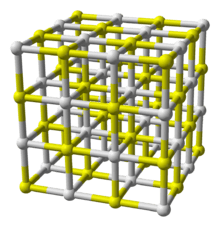Calcium sulfide
 | |
| Names | |
|---|---|
| IUPAC name
Calcium sulfide | |
| Other names
Calcium monosulfide, Hepar calcies, Sulfurated lime Oldhamite | |
| Identifiers | |
3D model (JSmol) |
|
| ChemSpider | |
| ECHA InfoCard | 100.039.869 |
| EC Number | 243-873-5 |
| KEGG | |
PubChem CID |
|
| UNII | |
| |
| |
| Properties | |
| CaS | |
| Molar mass | 72.143 g/mol |
| Appearance | white crystals hygroscopic |
| Density | 2.59 g/cm3 |
| Melting point | 2,525 °C (4,577 °F; 2,798 K) |
| hydrolyses | |
| Solubility | insoluble in alcohol reacts with acid |
Refractive index (nD) |
2.137 |
| Structure | |
| Halite (cubic), cF8 | |
| Fm3m, No. 225 | |
| Octahedral (Ca2+); octahedral (S2−) | |
| Hazards | |
| Main hazards | H2S source |
EU classification (DSD) (outdated) |
Irritant (Xi) Dangerous for the environment (N) |
| R-phrases (outdated) | R31, R36/37/38, R50 |
| S-phrases (outdated) | (S2), S28, S61 |
| NFPA 704 | |
| Related compounds | |
Other anions |
Calcium oxide |
Other cations |
Magnesium sulfide Strontium sulfide Barium sulfide |
Related sulfides |
Sodium sulfide |
Except where otherwise noted, data are given for materials in their standard state (at 25 °C [77 °F], 100 kPa). | |
| Infobox references | |
Calcium sulfide is the chemical compound with the formula CaS. This white material crystallizes in cubes like rock salt. CaS has been studied as a component in a process that would recycle gypsum, a product of flue-gas desulfurization. Like many salts containing sulfide ions, CaS typically has an odour of H2S, which results from small amount of this gas formed by hydrolysis of the salt.
In terms of its atomic structure, CaS crystallizes in the same motif as sodium chloride indicating that the bonding in this material is highly ionic. The high melting point is also consistent with its description as an ionic solid. In the crystal, each S2− ion is surrounded by an octahedron of six Ca2+ ions, and complementarily, each Ca2+ ion surrounded by six S2− ions.
Production
CaS is produced by "carbothermic reduction" of calcium sulfate, which entails the conversion of carbon, usually as charcoal, to carbon dioxide:
- CaSO4 + 2 C → CaS + 2 CO2
and can react further:
- 3 CaSO4 + CaS → 4 CaO + 4 SO2
In the second reaction the sulfate (+6 oxidation state) oxidizes the sulfide (-2 oxidation state) to sulfur dioxide (+4 oxidation state), while it is being reduced to sulfur dioxide itself (+4 oxidation state).
CaS is also a byproduct in the Leblanc process.
Milk of lime, Ca(OH)2, reacts with elemental sulfur to give a "lime-sulfur", which has been used as an insecticide. The active ingredient is probably a calcium polysulfide, not CaS.[1]
Reactivity and uses
Calcium sulfide decomposes upon contact with water, including moist air, giving a mixture of Ca(SH)2, Ca(OH)2, and Ca(SH)(OH).
- CaS + H2O → Ca(SH)(OH)
- Ca(SH)(OH) + H2O → Ca(OH)2 + H2S
It reacts with acids such as hydrochloric acid to release toxic hydrogen sulfide gas.
- CaS + 2 HCl → CaCl2 + H2S
Natural occurrence
Oldhamite is the name for mineralogical form of CaS. It is a rare component of some meteorites and has scientific importance in solar nebula research. Burning of coal dumps can also produce the compound.
